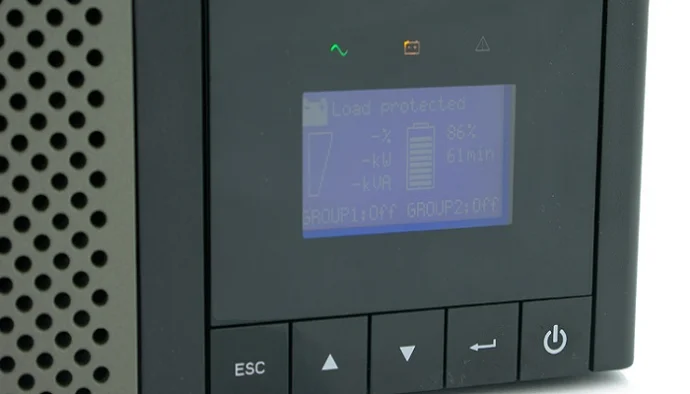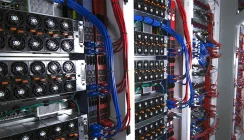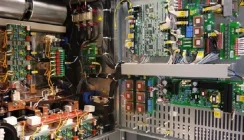Selecting an Uninterruptible Power Supply for Your Server Room
There are two fundamentals to cover when designing server room in terms of critical infrastructure. The first is cooling and the sizing of an air conditioning system to remove heat generated by the servers and provide a suitable working ambient. The second is the choice and sizing of a suitable uninterruptible power supply.
UPS Systems Checklist
A UPS system is designed to provide battery backup when the mains power supply fails. The battery is usually an internal one or may be housed in an external cabinet or tray for a rack mount UPS system. There are several aspects to consider when selecting the right uninterruptible power supply to protect your server room or datacentre environment.
- Load Sizing Per Phase: the first step is to decide how much power is to be drawn by the IT load and whether the loads require a single or three-phase. A comprehensive list of all the servers and related IT network equipment can be drawn up and a power value (in Watts or VA) can be assigned to the hardware alongside the mains power supply requirements in terms of single or three-phase. Most small server room and computer room systems will be single phase 230Vac 50Hz. Larger IT loads may require three phase 400Vac 50Hz mains power supplies. Power requirements for individual kit can be taken from rear rating plates, user manuals and manufacturer websites. This will provide an estimate and may potentially oversize the UPS system as most stated power ratings are total power ratings. A more effective measure can be taken by metering the individual loads or by working back to the nearest electrical sub-distribution board. Here, if all the critical power items are on a dedicated circuit or circuit(s), a UPS system can be sized to power up to the circuit breaker size within the distribution board or panel.
- Battery Runtime: the second step is to calculate how much backup power time is required. A typical installation running UPS monitoring and shutdown software may only need 10-15minutes. Alternatively, an installation may require an extended runtime (up to several hours) using either larger extended runtime battery packs or a standby power generator.
- UPS Power Protection Level: there are three types of UPS topology (defined in IEC 62040-3) ranging from offline/standby, line interactive to on-line. On-line UPS are sometimes referred to as double-conversion (AC-DC-AC) or triple-conversion (AC-DC-DC-AC) systems and provide the ultimate protection both when the mains power supply is present and during power outages. On-line UPS have a constantly running inverter section with a digitally generated sinewave output to which the load is connected. There is no break in supply when the mains power supply fails or is restored. The UPS also feature a ‘fail-safe-to-mains’ automatic bypass system should the UPS system be overloaded or suffer an internal fault. Line interactive UPS are smaller and lower in cost and provide intermediate power protection. Line interactive UPS may be suitable for small loads up to 2kVA which are less sensitive to millisecond power breaks and operating within a relatively power problem free environment. This type of UPS includes a small filtering circuit and automatic voltage stabiliser to provide some protection from sags, surges, brownouts, spikes and electrical noise. The inverter section may offer a sinewave or ‘pseudo’ (square or trapezoidal) sinewave) and there may be a switching period of 2-4milliseconds when the battery kicks in. Offline/standby UPS are generally available up to 2kVA and offer basic power protection with filtering for when mains power is present and a square-wave output. Offline UPS are suitable for desktop PCs, terminals and small IT peripherals. Line interactive and on-line UPS systems are preferred for small computer and server room installations, with on-line UPS preferred for critical server room and datacentre applications. For more information on UPS topologies and IEC 62040-3 visit: https://ieeexplore.ieee.org/document/844643
These are the basic of choosing an uninterruptible power supply for a server room environment: load size and matching to the mains power supply characteristics, the battery runtime required, and type of UPS topology preferred. Once this assessment has been made other considerations can be made.
Growth, Resilience and Modular UPS Systems
The next step is growth and resilience level required. It is considered best practice to add 20% to the load profile for future expansion. This applies to mono block UPS. If more expansion is required, then then a mono block UPS must be oversized, or one chosen that can be installed with the capability of parallel expansion for N+x resilience.
In an on-line UPS system, the built-in automatic bypass provides protection from a single point of failure. If the UPS suffers an overload or fault condition, the critical load is transferred to the bypass supply without a break in supply and downtime. In a resilient UPS installation, two or more UPS systems are installed to share the load, with the potential capacity to support the entire load if one of the UPS systems suffers a fault condition or is taken out of circuit.
Modular UPS systems tackle both future expansion and resilience by design. A modular UPS uses standard frame sizes, housing several standard-sized UPS modules. For example a 20kW frame using 10kW modules, a 180kW UPS frame using multiple of 30kW modules or a 300kW frame using 50kW modules. The UPS can be installed with one or two or more modules from day-one, with additional modules added as required.
Modular UPS tend to use a tower format matching that of server rack cabinets. They provide a way to make the most of the floor space within a server room or datacentre can are designed to scale vertically. Additional modular UPS frames can be installed in parallel to scale the installation horizontally. Modular UPS also tend to be designed for three phase and higher power ratings. Smaller single phase (1/1 and 3/1) formats are available. Some smaller modular UPS systems are also available with self-contained frames that can be installed within an existing server cabinet.
Space availability is therefore one of the other key considerations for a UPS installation. Smaller UPS systems may be installed alongside a server rack as a floor standing tower or within the rack as a rack mount cabinet. The larger the uninterruptible power supply, the greater the space required and this space increases as more battery runtime is required. For large datacentre applications, the UPS system may require a separate UPS and battery room(s) and a centralised rather than a decentralised approach.
Summary
It is relatively easy to size and select an uninterruptible power supply and battery for a server room or datacentre environment. There is little difference in the basics other than scale and the complexity of the overall installation. Thought should also be given to maintenance provision in the form of a UPS maintenance bypass switch and preventative maintenance contracts in order to ensure that whichever type of system is installed is inspected and maintained at least once a year and without downtime to the connected loads.


























